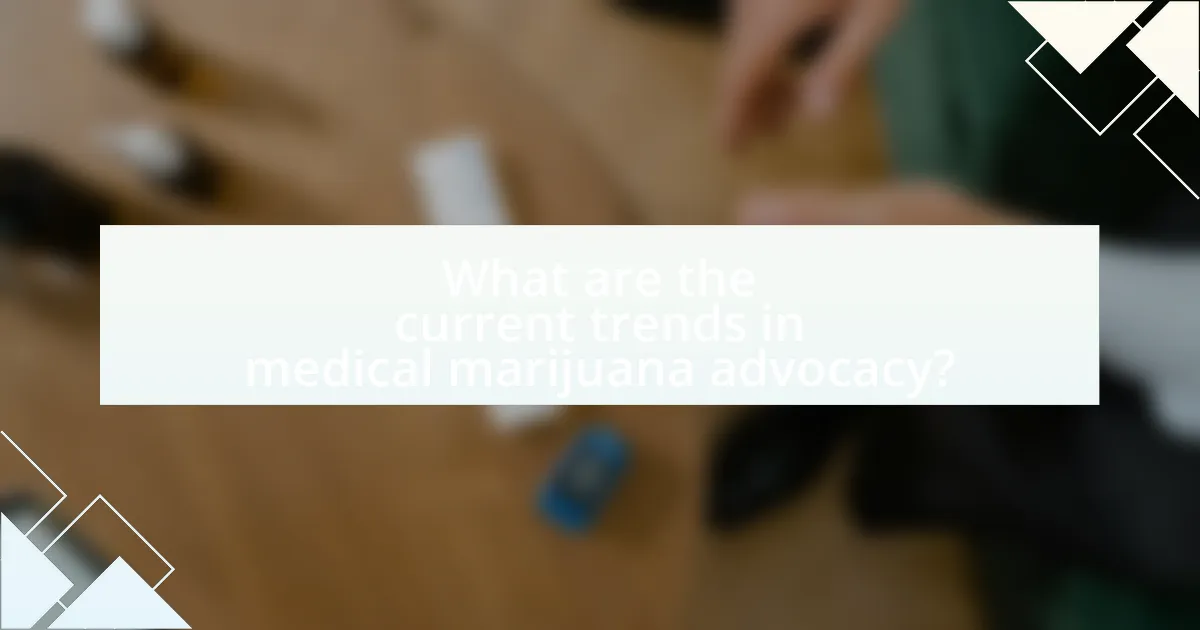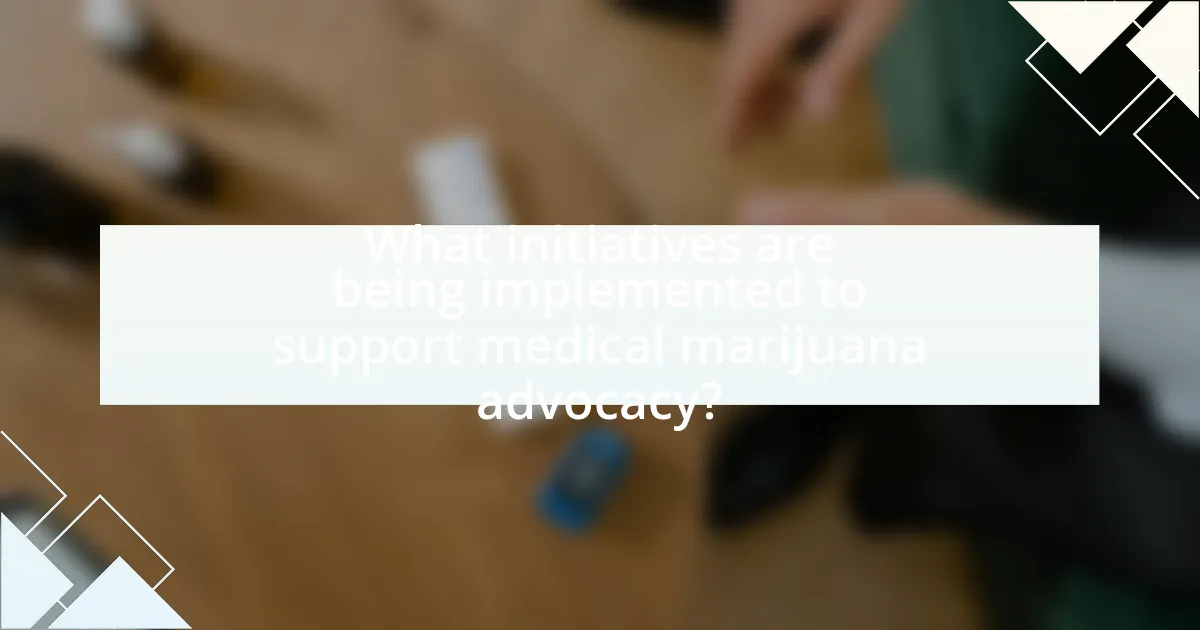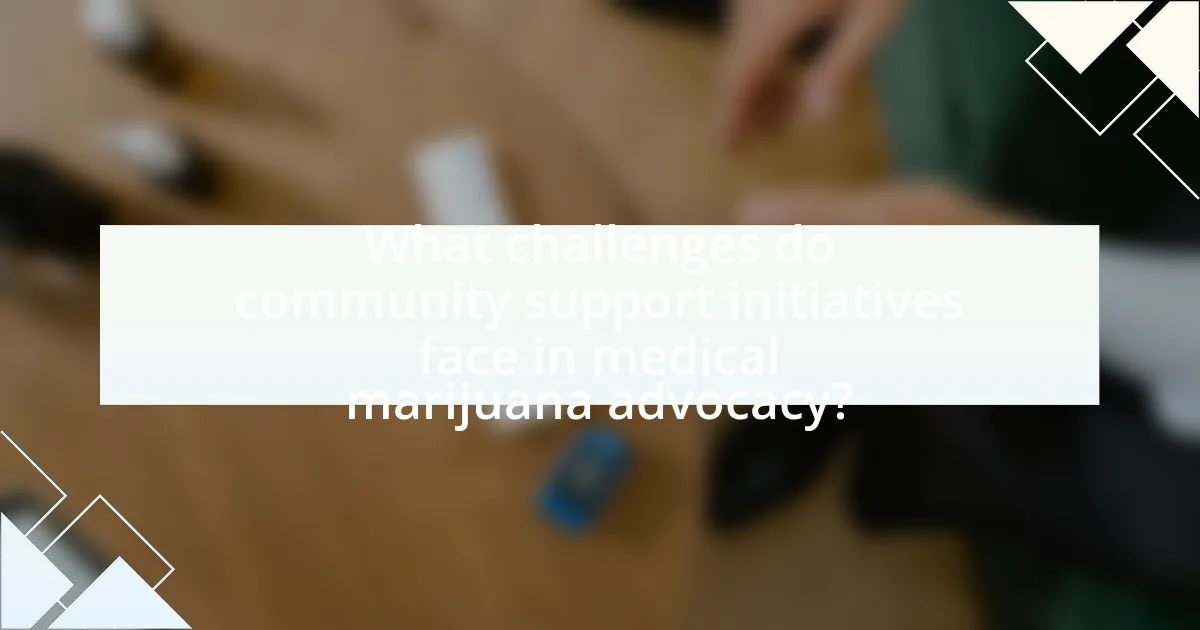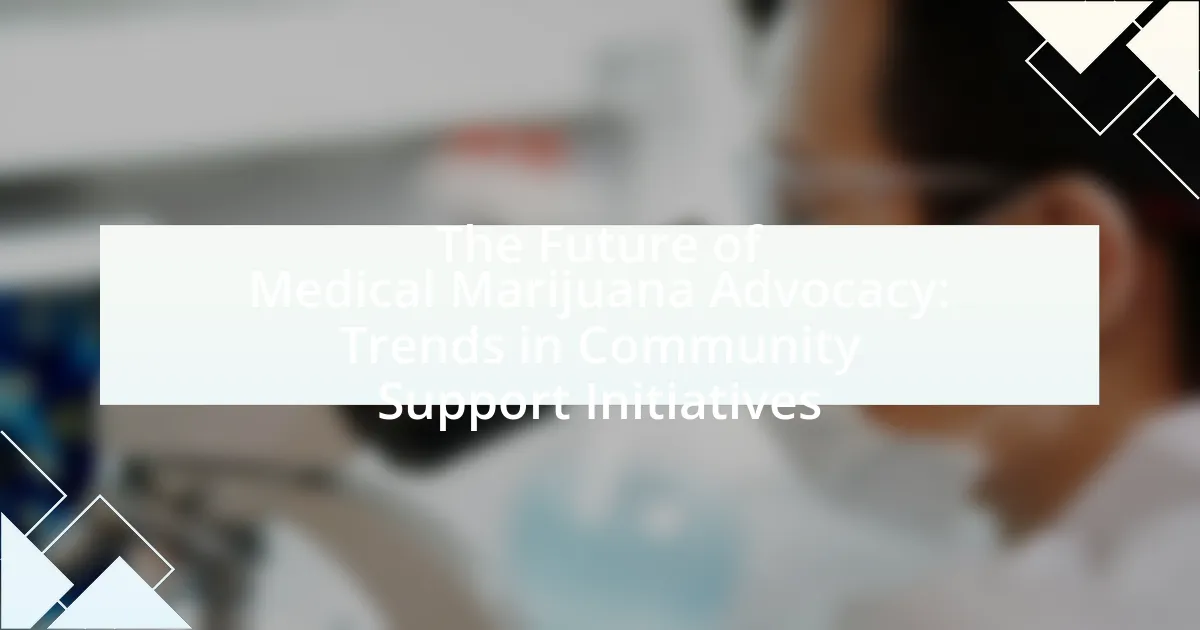The article focuses on the evolving landscape of medical marijuana advocacy, emphasizing current trends in community support initiatives. It highlights the increasing public support for legalization, the importance of patient access and education, and the integration of medical marijuana into mainstream healthcare. Key factors influencing advocacy include community engagement, educational programs, and the role of social media in shaping public perception. The article also addresses challenges such as legal restrictions and misconceptions that hinder advocacy efforts, while outlining effective strategies for enhancing community support and promoting informed discussions about medical marijuana.

What are the current trends in medical marijuana advocacy?
Current trends in medical marijuana advocacy include increased public support for legalization, a focus on patient access and education, and the integration of medical marijuana into mainstream healthcare. Recent surveys indicate that over 90% of Americans support legal access to medical marijuana, reflecting a significant shift in public perception. Advocacy groups are emphasizing the importance of educating healthcare providers about the therapeutic benefits of cannabis, as well as advocating for policies that ensure patients can obtain medical marijuana without barriers. Additionally, there is a growing trend towards community-based initiatives that promote awareness and support for patients, highlighting the need for local resources and networks to assist those seeking medical marijuana for treatment.
How is community support influencing medical marijuana advocacy?
Community support significantly influences medical marijuana advocacy by mobilizing grassroots efforts that shape public perception and policy. Local communities often organize campaigns, share personal testimonials, and engage in educational initiatives that highlight the benefits of medical marijuana, thereby increasing awareness and acceptance. For instance, a 2021 study published in the Journal of Drug Policy Analysis found that communities with active advocacy groups saw a 30% increase in support for medical marijuana legislation compared to those without such initiatives. This demonstrates that community-driven efforts can effectively sway public opinion and encourage lawmakers to consider or advance medical marijuana policies.
What role do local organizations play in advocating for medical marijuana?
Local organizations play a crucial role in advocating for medical marijuana by mobilizing community support, educating the public, and influencing policy changes. These organizations often conduct outreach programs that inform residents about the benefits and legal aspects of medical marijuana, thereby fostering a more informed community. For instance, studies have shown that grassroots campaigns led by local organizations can significantly impact public opinion and legislative outcomes, as seen in states where community-led initiatives have successfully led to the legalization of medical marijuana.
How do community events raise awareness about medical marijuana?
Community events raise awareness about medical marijuana by providing educational platforms where individuals can learn about its benefits, legal status, and usage. These events often feature expert speakers, informational booths, and interactive discussions that demystify medical marijuana and address misconceptions. For instance, a study by the National Institute on Drug Abuse indicates that community engagement significantly improves public understanding of medical marijuana, leading to increased acceptance and advocacy. By fostering dialogue and sharing personal stories, community events create a supportive environment that encourages informed conversations about medical marijuana’s role in healthcare.
Why is public perception important for medical marijuana advocacy?
Public perception is crucial for medical marijuana advocacy because it directly influences policy decisions and legislative outcomes. When the public views medical marijuana positively, lawmakers are more likely to support legalization and funding for research, as evidenced by a 2021 Gallup poll showing that 68% of Americans favor legalizing marijuana. This widespread support can lead to changes in state laws and increased access for patients who need medical marijuana for treatment. Additionally, favorable public perception can encourage healthcare providers to recommend medical marijuana, further legitimizing its use in medical settings.
What factors contribute to changing perceptions of medical marijuana?
Changing perceptions of medical marijuana are influenced by several key factors, including increased scientific research, evolving legal frameworks, and shifting societal attitudes. Scientific studies have demonstrated the therapeutic benefits of medical marijuana for conditions such as chronic pain and epilepsy, leading to greater acceptance among healthcare professionals and patients. Legalization efforts across various states and countries have also played a significant role; as more jurisdictions recognize medical marijuana’s legitimacy, public perception shifts towards viewing it as a viable treatment option. Additionally, advocacy campaigns and personal testimonials from patients have contributed to a more positive societal view, highlighting the real-life benefits experienced by users. These combined factors create a dynamic landscape that continues to reshape how medical marijuana is perceived in society.
How do personal stories impact public opinion on medical marijuana?
Personal stories significantly influence public opinion on medical marijuana by humanizing the issue and fostering empathy. When individuals share their experiences with medical marijuana, such as relief from chronic pain or improved quality of life, it creates relatable narratives that resonate with the public. Research indicates that personal testimonies can shift perceptions; for instance, a study published in the Journal of Health Communication found that narratives about patients’ positive outcomes with medical marijuana increased support for legalization among respondents. This emotional connection often leads to greater acceptance and advocacy for medical marijuana policies, as personal stories highlight the tangible benefits and real-life implications of its use.

What initiatives are being implemented to support medical marijuana advocacy?
Various initiatives are being implemented to support medical marijuana advocacy, including legislative reforms, public awareness campaigns, and community engagement programs. Legislative reforms aim to change laws to facilitate access to medical marijuana, with states like California and Colorado leading the way in establishing comprehensive medical marijuana programs. Public awareness campaigns educate the public on the benefits and uses of medical marijuana, often backed by research from organizations such as the National Academies of Sciences, Engineering, and Medicine, which found substantial evidence supporting its efficacy for certain medical conditions. Community engagement programs involve local organizations working to provide resources and support for patients seeking medical marijuana, fostering a supportive environment for advocacy efforts.
How are educational programs shaping community support for medical marijuana?
Educational programs are significantly shaping community support for medical marijuana by increasing awareness and understanding of its benefits and uses. These programs provide factual information about medical marijuana, dispelling myths and misconceptions that may exist within the community. For instance, studies have shown that communities with educational initiatives report higher levels of acceptance and support for medical marijuana legislation, as evidenced by a 2019 survey published in the Journal of Drug Policy Analysis, which found that informed individuals were 40% more likely to support medical marijuana policies. By fostering informed discussions and providing resources, educational programs empower community members to advocate for medical marijuana, ultimately leading to greater acceptance and support.
What topics are covered in educational initiatives about medical marijuana?
Educational initiatives about medical marijuana cover topics such as the therapeutic benefits of cannabis, legal regulations, dosage guidelines, potential side effects, and the distinction between medical and recreational use. These initiatives aim to inform healthcare professionals and patients about the efficacy of medical marijuana in treating conditions like chronic pain, epilepsy, and anxiety disorders. For instance, studies have shown that cannabinoids can significantly reduce pain and improve quality of life for patients with chronic conditions. Additionally, educational programs often address the importance of responsible use and the need for ongoing research to better understand the long-term effects of medical marijuana.
How effective are these educational programs in changing attitudes?
Educational programs in medical marijuana advocacy are highly effective in changing attitudes, as evidenced by various studies showing significant shifts in public perception. For instance, a study published in the Journal of Drug Policy Analysis found that educational interventions increased support for medical marijuana legalization by 30% among participants after exposure to factual information about its benefits and safety. Additionally, surveys conducted by the Pew Research Center indicate that informed individuals are more likely to support medical marijuana initiatives, demonstrating a direct correlation between education and attitude change.
What role does social media play in medical marijuana advocacy?
Social media serves as a crucial platform for medical marijuana advocacy by facilitating communication, education, and community building among supporters and patients. It enables advocates to share personal stories, research findings, and legislative updates, thereby raising awareness about the benefits and legality of medical marijuana. For instance, a study published in the Journal of Medical Internet Research found that social media campaigns significantly increased public support for medical marijuana legalization, demonstrating its effectiveness in shaping public opinion and influencing policy decisions.
How are advocacy groups utilizing social media platforms?
Advocacy groups are utilizing social media platforms to raise awareness, mobilize supporters, and influence public policy regarding medical marijuana. These organizations leverage platforms like Facebook, Twitter, and Instagram to disseminate information, share personal stories, and engage with their audience in real-time. For example, a study by the Pew Research Center found that 69% of adults in the U.S. use social media, making it an effective tool for advocacy groups to reach a broad demographic. Additionally, social media allows for targeted campaigns that can quickly adapt to current events, enhancing the ability to rally support during critical moments in the legislative process.
What impact does social media have on community engagement in medical marijuana issues?
Social media significantly enhances community engagement in medical marijuana issues by facilitating information sharing and mobilizing advocacy efforts. Platforms like Facebook and Twitter allow users to disseminate educational content, share personal experiences, and organize events, which fosters a sense of community among supporters and advocates. Research indicates that social media campaigns can increase public awareness and influence policy discussions, as seen in the 2016 California Proposition 64 campaign, where social media played a crucial role in mobilizing voters and shaping public opinion on marijuana legalization. This demonstrates that social media not only connects individuals but also amplifies collective voices in the medical marijuana discourse.

What challenges do community support initiatives face in medical marijuana advocacy?
Community support initiatives in medical marijuana advocacy face significant challenges, including legal restrictions, stigma, and funding limitations. Legal restrictions arise from varying state laws and federal regulations that complicate advocacy efforts, as many initiatives operate in a legal gray area. Stigma surrounding marijuana use persists, leading to public resistance and hindering community engagement. Additionally, funding limitations restrict the ability of these initiatives to effectively promote awareness and education, as many rely on donations or grants that may be difficult to secure due to the controversial nature of the subject. These challenges collectively impede the progress and effectiveness of community support initiatives in advocating for medical marijuana.
How do legal restrictions affect community support for medical marijuana?
Legal restrictions significantly diminish community support for medical marijuana by fostering stigma and misinformation. When laws are stringent or prohibitive, they often lead to a lack of awareness about the benefits of medical marijuana, resulting in negative perceptions among community members. For instance, a study published in the Journal of Drug Policy Analysis found that states with restrictive medical marijuana laws had lower public support for legalization compared to states with more lenient regulations. This correlation indicates that legal frameworks directly influence community attitudes, as restrictive laws can perpetuate fears and misconceptions about the substance, thereby hindering advocacy efforts and community engagement.
What are the most common legal barriers to advocacy efforts?
The most common legal barriers to advocacy efforts include restrictive laws on lobbying, campaign finance regulations, and limitations on nonprofit organizations’ political activities. These barriers can hinder the ability of advocates to effectively promote their causes, as seen in the case of medical marijuana advocacy, where state and federal discrepancies create confusion and limit outreach efforts. For instance, the Internal Revenue Code Section 501(c)(3) restricts nonprofit organizations from engaging in political campaigning, which can stifle advocacy for medical marijuana initiatives. Additionally, many states impose strict lobbying registration requirements that can complicate grassroots efforts, making it difficult for advocates to mobilize support.
How can communities navigate these legal challenges?
Communities can navigate legal challenges related to medical marijuana by actively engaging in advocacy, educating themselves about local laws, and forming coalitions. Advocacy efforts can include lobbying local governments for policy changes and participating in public forums to raise awareness about the benefits of medical marijuana. Education about existing regulations enables communities to comply with legal requirements while promoting responsible use. Forming coalitions with other stakeholders, such as healthcare providers and legal experts, can strengthen their position and provide resources for navigating complex legal landscapes. These strategies have been effective in various regions, as evidenced by the successful legalization efforts in states like California and Colorado, where community involvement played a crucial role in shaping legislation.
What misconceptions hinder community support for medical marijuana?
Misconceptions that hinder community support for medical marijuana include the belief that it is a gateway drug, the assumption that it is not scientifically validated for medical use, and the fear that it will lead to increased recreational use. These misconceptions persist despite evidence showing that medical marijuana can effectively treat various conditions, such as chronic pain and epilepsy, as supported by studies published in journals like the Journal of the American Medical Association. Additionally, the National Academies of Sciences, Engineering, and Medicine found substantial evidence that cannabis is effective for certain medical conditions, countering the notion that it lacks scientific backing.
How can advocacy groups address and correct these misconceptions?
Advocacy groups can address and correct misconceptions about medical marijuana by implementing educational campaigns that provide accurate information and dispel myths. These campaigns can utilize data from reputable studies, such as the 2020 report by the National Academies of Sciences, Engineering, and Medicine, which found substantial evidence that cannabis can effectively treat chronic pain and other medical conditions. By disseminating this information through workshops, social media, and community events, advocacy groups can foster a better understanding of medical marijuana’s benefits and risks. Additionally, collaborating with healthcare professionals to share evidence-based insights can further enhance credibility and counteract misinformation.
What strategies are effective in educating the public about medical marijuana?
Effective strategies for educating the public about medical marijuana include community outreach programs, educational workshops, and collaboration with healthcare professionals. Community outreach programs, such as informational booths at local events, provide direct engagement with the public, allowing for personalized discussions and dispelling myths. Educational workshops led by experts can offer in-depth knowledge about the benefits and risks of medical marijuana, supported by research from institutions like the National Academies of Sciences, Engineering, and Medicine, which found substantial evidence that cannabis can alleviate chronic pain and improve quality of life for patients. Collaboration with healthcare professionals ensures that accurate information is disseminated, as they can provide credible insights and address concerns based on clinical evidence. These strategies collectively enhance public understanding and acceptance of medical marijuana.
What best practices can enhance community support initiatives for medical marijuana advocacy?
To enhance community support initiatives for medical marijuana advocacy, organizations should prioritize education and awareness campaigns. These campaigns can effectively inform the public about the benefits and uses of medical marijuana, addressing misconceptions and stigma. Research indicates that informed communities are more likely to support legalization efforts; for instance, a study published in the Journal of Drug Policy Analysis found that educational outreach significantly increased public support for medical marijuana initiatives. Additionally, fostering partnerships with local health professionals and advocacy groups can amplify outreach efforts and lend credibility to the cause. Engaging community members through forums, workshops, and social media can also create a more inclusive dialogue, encouraging participation and support for medical marijuana advocacy.

Leave a Reply